Introduction
So you’re planning a trip to the Middle East. You’re about to embark on a journey full of adventure, culture, and possibly some questionable fashion choices. But before you can start packing (btw, read my ultimate packing guide for the Middle East), there’s one important question to answer: what should you wear?
Dressing appropriately is crucial, as it can affect how you’re perceived by locals and how comfortable you feel during your travels. And let’s be real, you don’t want to stick out like a sore thumb or feel like a walking sauna. So, to help you navigate the sartorial minefield that is the Middle East, I’ve put together this guide. But fair warning, this is not your average packing guide. If you’re expecting a boring list of items, you’re in for disappointment (for that, you can still check out my Middle East ultimate packing guide). Instead, in this guide, I will cover clothing in the Middle East from a more general and holistic perspective. So buckle up, grab your abaya (just kidding. Or maybe not), and get ready for some fashion advice that’s as spicy as shakshouka.
What to wear in the Middle East?
Cover up or face the wrath of the sun
First, let’s make a digression on what to wear in the Middle East. Navigating clothing choices in the Middle East can be a bit tricky. While some countries may be more or less conservative than others, the general rule of thumb is to dress modestly. And, let’s be real, it’s hot as hell in the Middle East, so you might be tempted to strip down to the bare minimum. But the area is also predominantly Muslim, so you can’t. And you shouldn’t want to either. That’s because 1) if dressing conservatively also conveys a sense of respect towards the local culture, I would say that’s a no-brainer, and 2) the locals know a thing or two about beating the heat – covering up can actually provide more insulation and protection from the sun, making you feel cooler in the long run.

Dress modestly and respectfully
All right, I’m sold, but how should I actually dress? In layman’s terms, you want to avoid tight or revealing clothing and make sure your knees, shoulders, and chest are covered. During Ramadan, it’s best to cover legs and arms entirely. Sorry guys, those muscle tees aren’t going to cut it. And ladies, if you’re planning on wearing a crop top, make sure you have a light cardigan or scarf handy to cover up as needed. Oh, and please forget about rocking your Daisy Dukes at the local bazaar. For those interested in taking it up a notch, this style of dressing is sometimes referred to as modest fashion. (Side note: if any modest fashion influencers are reading this, please teach me how to wear a headscarf without looking like I just failed at a robbery.)

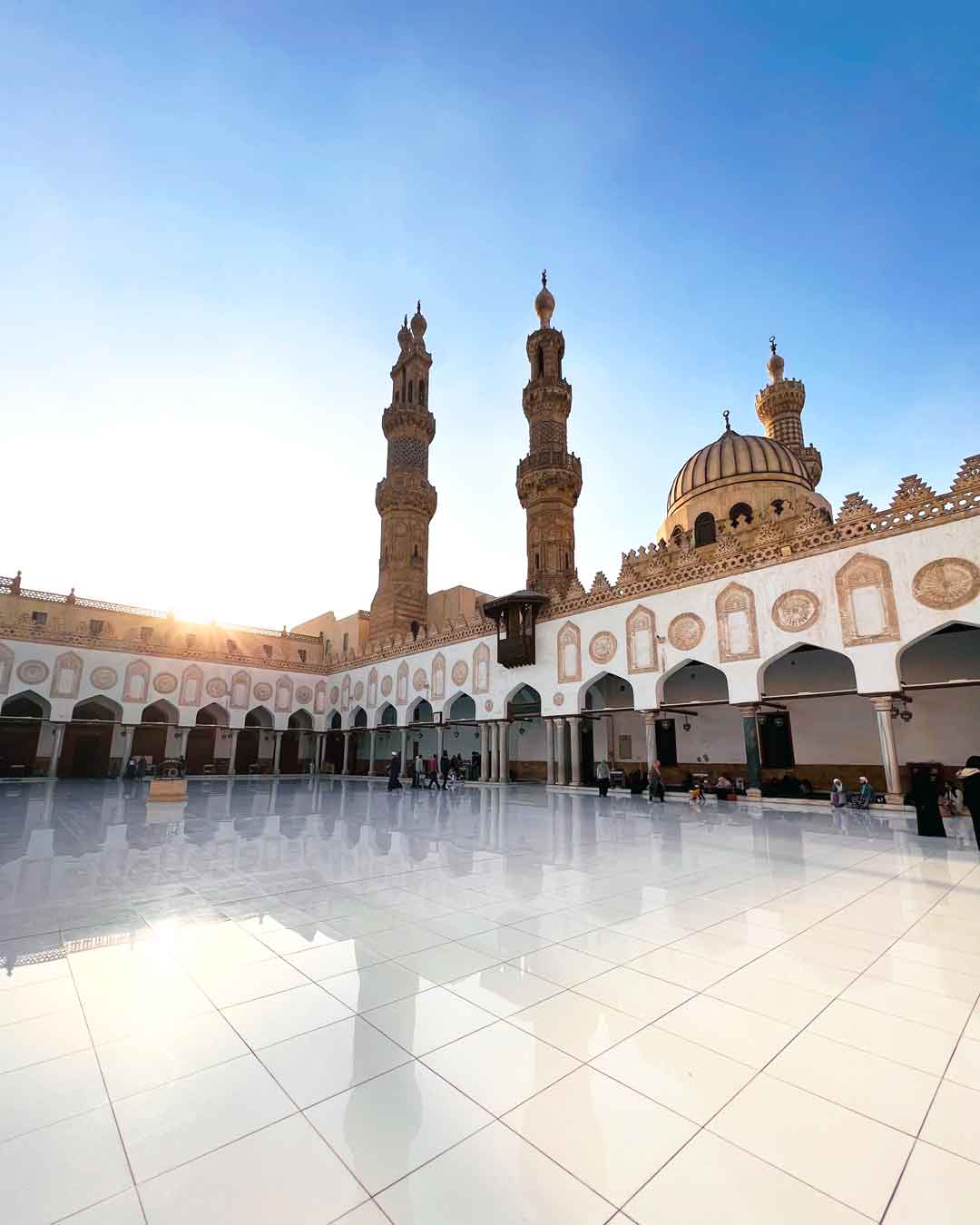
Dress like an onion
Now that we’ve got the concept of dressing conservatively out of the way, let’s talk about the climate in the Middle East. And let me tell you, it’s hot. Like, really hot. I’m talking “traumatized in Qatar” levels of hot. So, what’s the key to surviving this scorching climate? Layering up with lightweight and breathable clothing, that’s what. Think cotton, linen, and rayon – and avoid anything synthetic unless you want to feel like you’re trapped in a sauna blanket.
Now, I know what you’re thinking: But Aurora, why would I want to wear layers in such a hot climate? Well, my friend, it’s not just a fashion statement, it’s science. Wearing multiple layers actually provides better insulation for your skin against the extreme heat. Plus, having layers comes in handy especially during the mildest months when sudden gusts of wind can make you feel chilly. And don’t even get me started on the temperature differences between indoor and outdoor areas during the hottest months that can leave you feeling like you’re in a sauna one moment and teleported to the North Pole the next. And if you’re traveling during the colder months, don’t forget to pack a warm jacket. Trust me, I love cryotherapy as much as the next person, but walking around Jordan in a t-shirt when it’s 8ºC with a strong wind is not exactly pleasant. So, dress like an onion and layer up!
Fun fact
Have you ever heard of the Italian expression “vestirsi a cipolla”? It means “dress like an onion” and we use it when the weather is unpredictable and fluctuates between hot and cold. I believe this technique is the best hack to tackle the weather in the Middle East. Not because it can suddenly become cold (except for winter in some areas), but because layering up can protect you from the heat.

Scarves are lifesavers
However, a special mention must go to scarves. You might think that wearing a scarf in the Middle East is just something that makes you look cool in your Instagram posts, but let me tell you, it’s a lifesaver. Not only does it protect you from the scorching sun and the ruthless wind, but it’s also a must-have accessory for blending in with local people and for entering mosques. Yes, that’s right, mosques have a strict “no bare skin” policy, so unless you want to be denied entry and spend your day twiddling your thumbs outside, wrap that scarf around your head and shoulders. And if you’re feeling bold, you can even use it as a shield against sandstorms, or as a makeshift rope to climb out of a tricky situation (results aren’t guaranteed tho, as I haven’t tried this personally. Yet).


Don't forget about your feet
Lastly, don’t forget about your feet. When it comes to footwear in the Middle East, you want to make sure you’re prepared for anything. That’s right, even your shoes need to be ready for action. You don’t want to be caught in a sandstorm wearing flip-flops (it kinda happened to me and let’s just say it wasn’t a walk in the park) or limping around with blisters from your stilettos. Trust me, it’s not a good look. Instead, opt for something supportive and sturdy, like sneakers or hiking boots. You’ll thank yourself when you’re exploring more remote areas like Petra in Jordan. Alternatively, when you’re just exploring the souks and mosques, if you want to fit in with the locals and avoid looking like a clueless tourist, there’s only one option: sandals. That’s right, strap on those open-toed wonders and let your toes breathe free. Plus, they’re great for slipping off quickly when entering mosques (because who doesn’t love a good game of “find your shoes” afterward?). Just make sure to leave the Crocs at home, because nothing screams “I’m not from around here” like a pair of those.
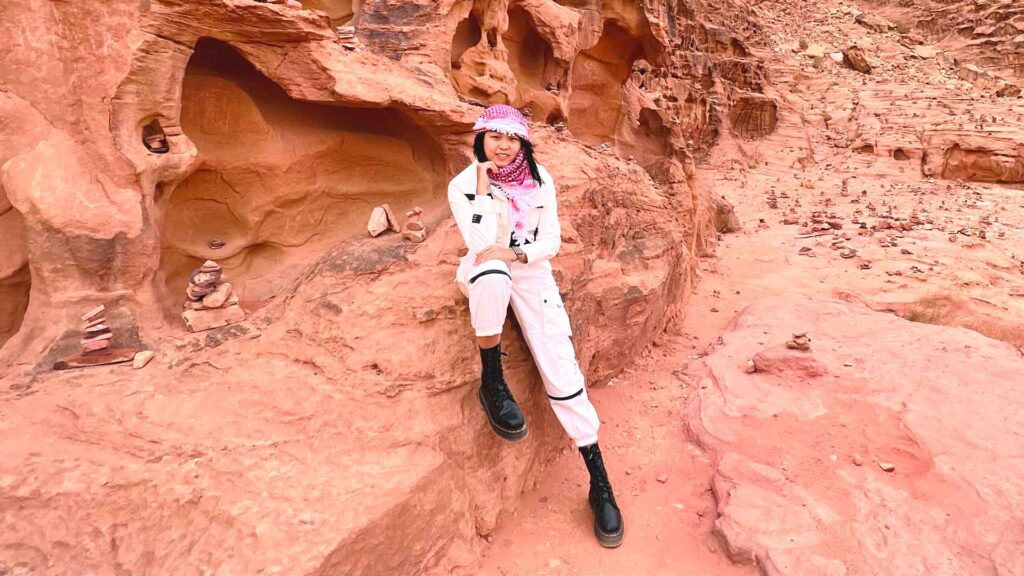
What about swimwear?
Ah, swimsuits in the Middle East – a topic that always manages to make a splash. Let’s start with the basics: yes, you can wear a swimsuit in the Middle East. But, as with everything in life, there are some rules to follow. First of all, forget about wearing that teeny-tiny bikini you just bought from Victoria’s Secret. The Middle East is not the place for showing off your assets, so leave the string bikinis at home. Instead, I would opt for a more conservative swimsuit that covers your midriff and has a higher neckline. Think of it as a way to avoid awkward tan lines – you’re welcome.
But wait, there’s more! In some countries, like Saudi Arabia and Iran, women are not allowed to swim in public at all. So, if you’re planning a beach holiday in those countries, you might want to reconsider your destination. However, in places like Oman and Dubai, there are plenty of beautiful private beaches where you can wear your favorite swimsuit without any issues. Same thing goes with high-end hotels’ pools and beaches in Qatar, Egypt, or Jordan, for example.
And let’s not forget about the men. Speedos are a big no-no in the Middle East – sorry, fellas. Instead, opt for a pair of swim shorts that are knee-length or longer. Bonus points if they have a fun print or bright color – just don’t go too wild. Remember, you want to blend in with the locals, not stand out like a sore thumb.
In summary, also when it comes to swimsuits in the Middle East, modesty is key. So pack your one-piece, leave the skimpy bikinis at home, and get ready to make a splash – but only in the appropriate places, of course.
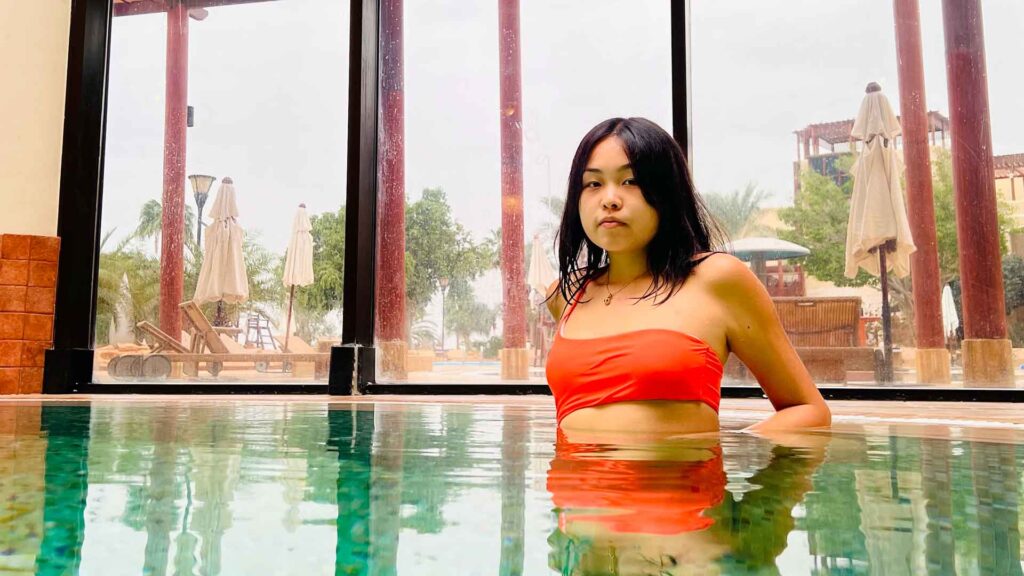
Country specifics
Egypt
In Egypt, it’s important to dress modestly, especially when visiting religious sites such as mosques and temples. Women should cover their shoulders and wear skirts or pants that cover their knees. Men should also avoid wearing shorts and sleeveless shirts in public. In tourist areas like Sharm El Sheikh or Hurghada, you can wear more casual clothing like shorts and tank tops, but it’s still best to dress modestly.
Iran
In Iran, women must wear a hijab that covers their hair and neck, and the clothing should be loose-fitting and cover the arms and legs. Men should also dress modestly, avoiding shorts and sleeveless shirts in public areas.
Jordan
Even if the Jordanian clothing etiquette is more relaxed than in many neighboring countries (e.g., Saudi Arabia or Iran), and Western clothing is generally acceptable, it is still advisable to dress conservatively. Women can wear pants and shirts with long sleeves, but it’s still best to avoid wearing shorts and sleeveless tops. Men can wear t-shirts and shorts, but should avoid wearing anything too revealing or tight-fitting. When visiting religious sites, both men and women should cover their shoulders and wear pants or long skirts that cover their ankles.
Moreover, Jordan generally has colder winters compared to other countries, so you’ll definitely want to bring some warmer layers.
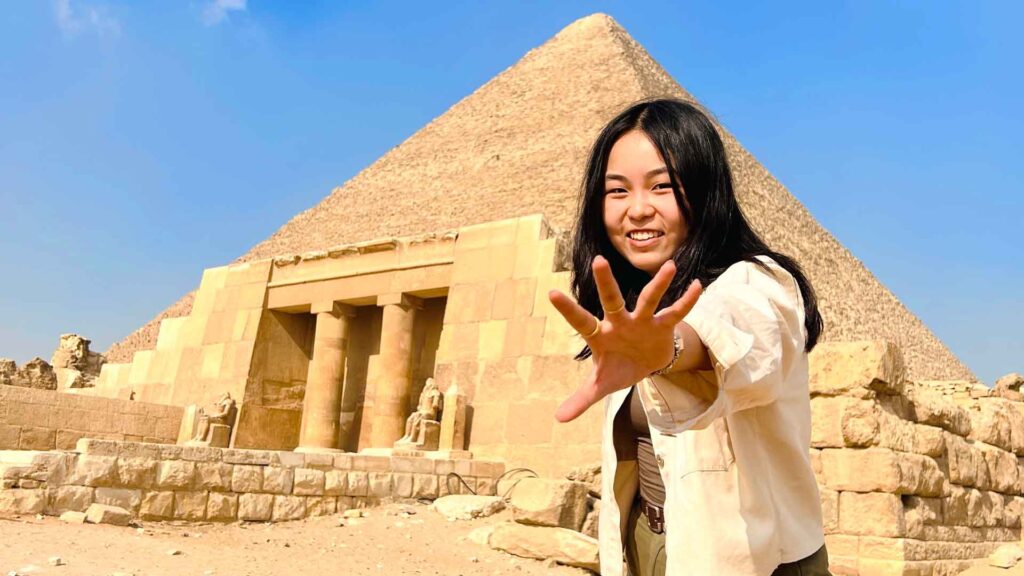
Lebanon
In Lebanon, the dress code is relatively liberal, especially in the capital city of Beirut, which is known for its trendy fashion scene. However, it is still important to dress modestly when visiting religious sites and conservative areas. In more rural areas, women may feel more comfortable wearing long-sleeved tops and long skirts or pants, while men may opt for long pants instead of shorts.
Oman
In Oman, the dress code is more conservative, especially for women. Women are expected to cover their hair, arms, and legs in public, with loose-fitting clothing that does not reveal the shape of their bodies. Men are also expected to dress conservatively, with long pants and shirts that cover their shoulders. It’s worth noting that the dress code is particularly strict during the holy month of Ramadan, with even stricter rules applying in and around mosques and other religious sites.
Qatar
In Qatar, modesty is highly valued, and clothing should reflect that. While Western-style clothing is generally acceptable, it’s important to avoid anything too revealing or tight-fitting. Women should avoid shorts and sleeveless tops, and instead opt for loose-fitting trousers or maxi skirts and long-sleeved shirts. Men should also dress modestly, avoiding shorts and sleeveless tops in public. When visiting mosques, both men and women should wear conservative clothing. In more upscale areas of Qatar, such as in luxury hotels and restaurants, smart casual attire is often the norm, and men may be expected to wear collared shirts and closed-toe shoes.

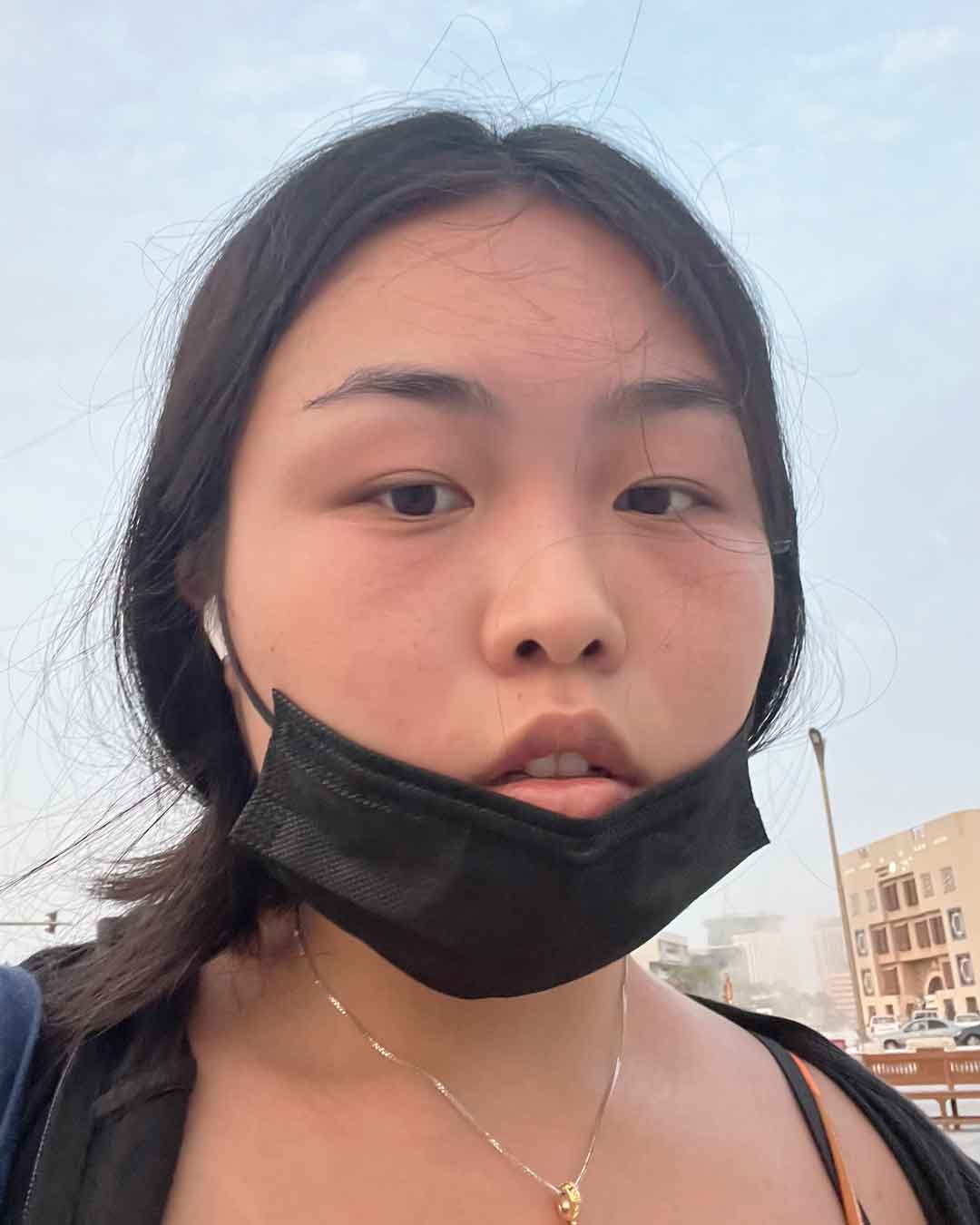
Saudi Arabia
In Saudi Arabia, women are required to wear an abaya, a loose, black cloak that covers the entire body except for the face, hands, and feet. Men should also dress modestly, avoiding shorts and sleeveless shirts in public areas. It is also recommended for both men and women to wear a headscarf, especially in religious sites.
Turkey
In Turkey, the dress code is generally more relaxed compared to other Middle Eastern countries. Western clothing is generally accepted in European Turkey (e.g., Istanbul). However, it’s important to dress modestly when visiting religious sites or conservative areas. There, women should avoid wearing shorts, tank tops, and revealing clothing, while men should avoid sleeveless shirts.
United Arab Emirates
Dubai and Abu Dhabi are among the most popular destinations in the UAE. While the dress code is relatively relaxed, it’s still important to dress modestly in public places. Women should cover their shoulders and knees, and avoid tight or revealing clothing. Men can wear shorts and t-shirts in public, but it’s best to avoid tank tops and clothing with offensive graphics.
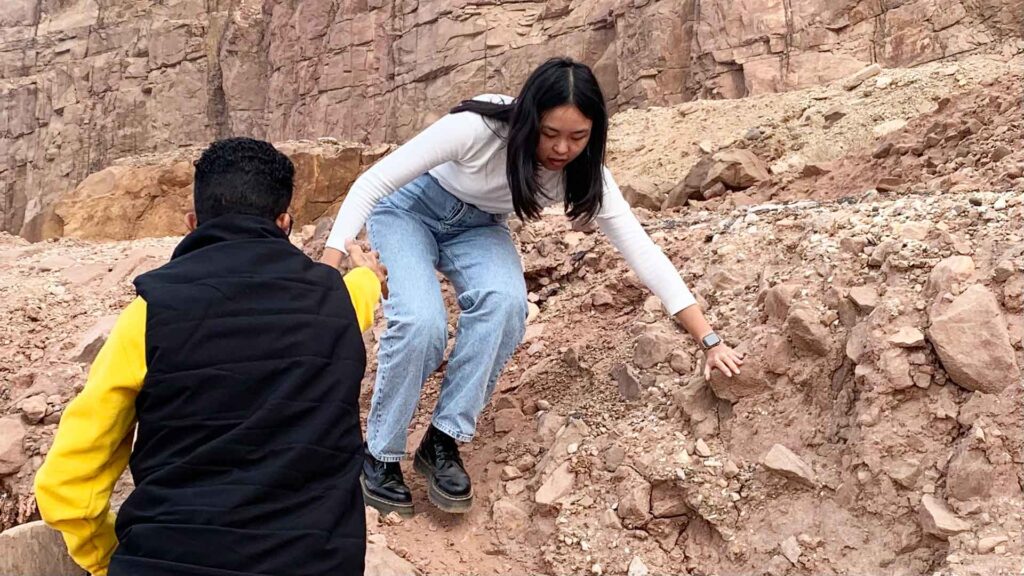
Conclusion
So there you have it, folks. What to wear for your Middle Eastern adventure! Remember to dress modestly and respectfully, choose lightweight and breathable fabrics, and pack for the weather and terrain. And most importantly, don’t forget those comfortable shoes! With a little bit of preparation, you’ll be ready (at least from a clothing perspective) to take on anything the region has to offer.
And now that you know everything about clothing in the Middle East, it’s time for you to start packing (dreadful, isn’t it?). For that, check out my actual ultimate packing guide for the Middle East. And remember, when it comes to clothing, keep in mind the weather and season when you plan your trip, as well as the specific country you’ll be visiting, like Jordan, Egypt, Qatar, or Turkey, and revise accordingly.
Save this on Pinterest!
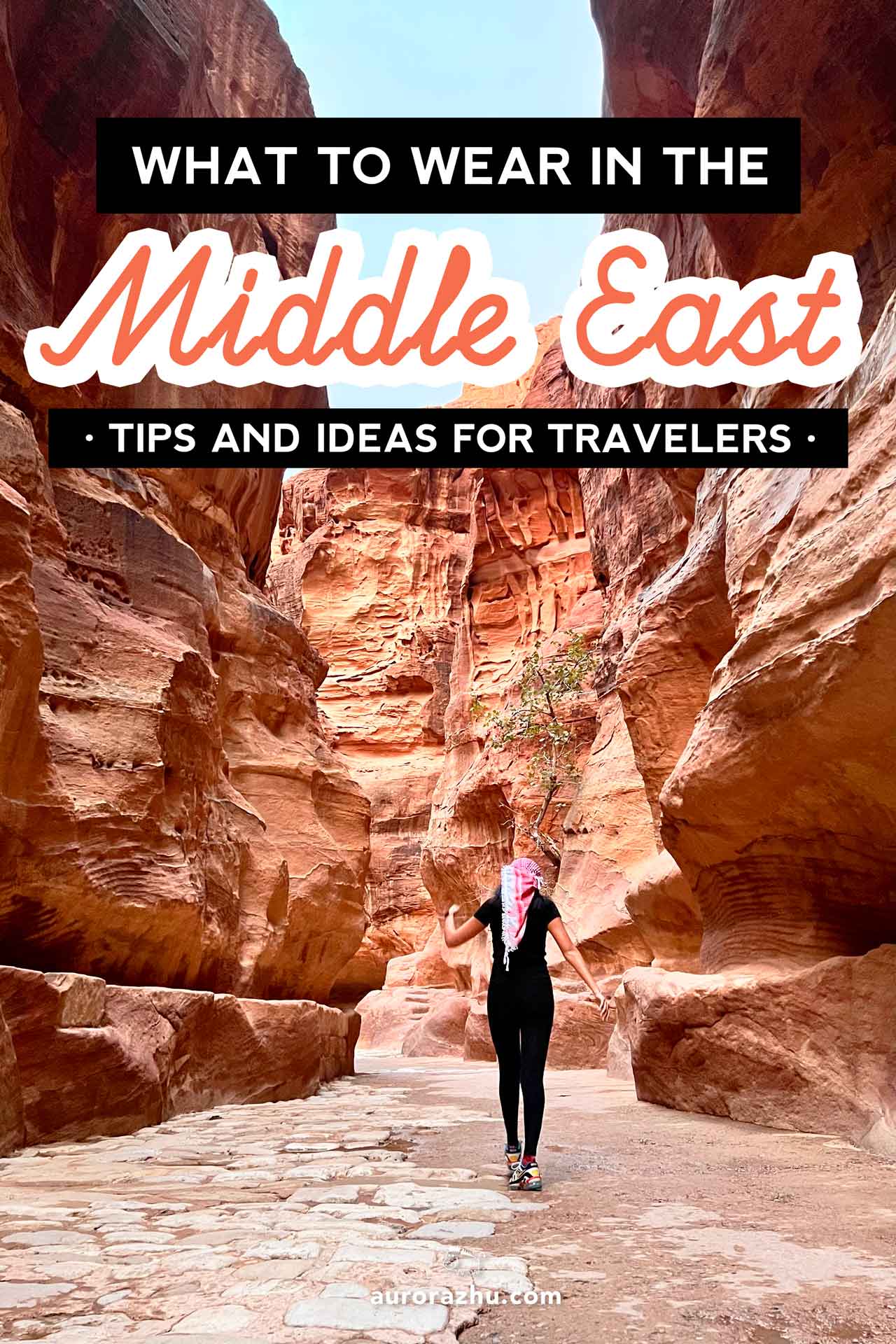



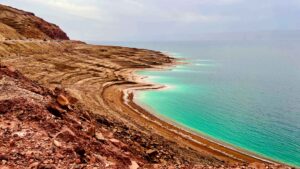




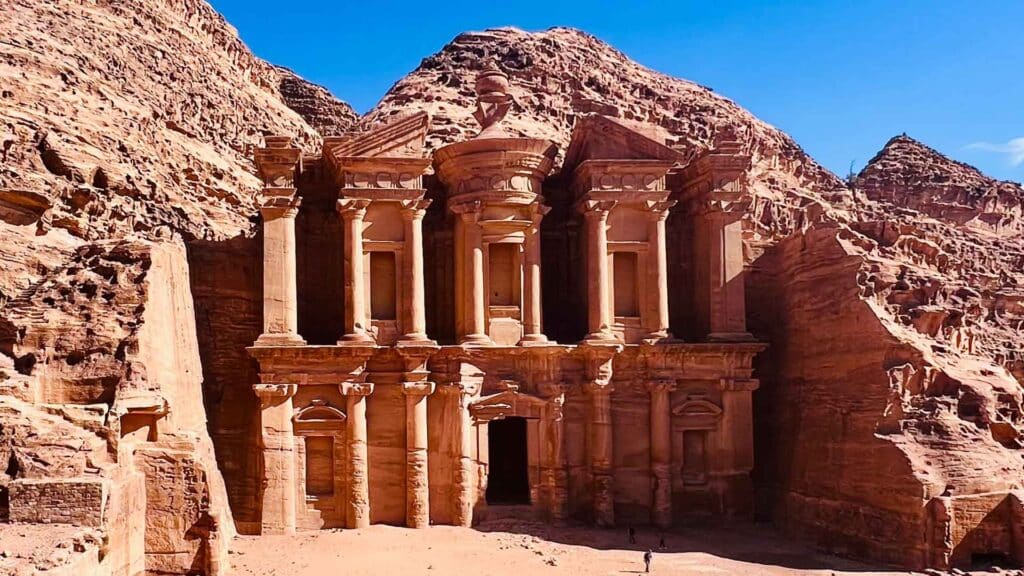
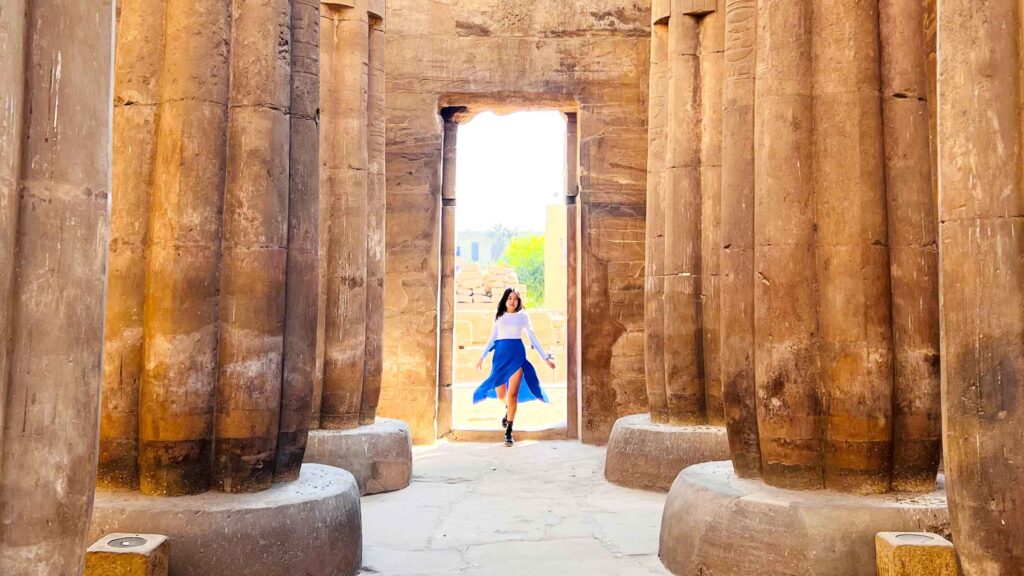
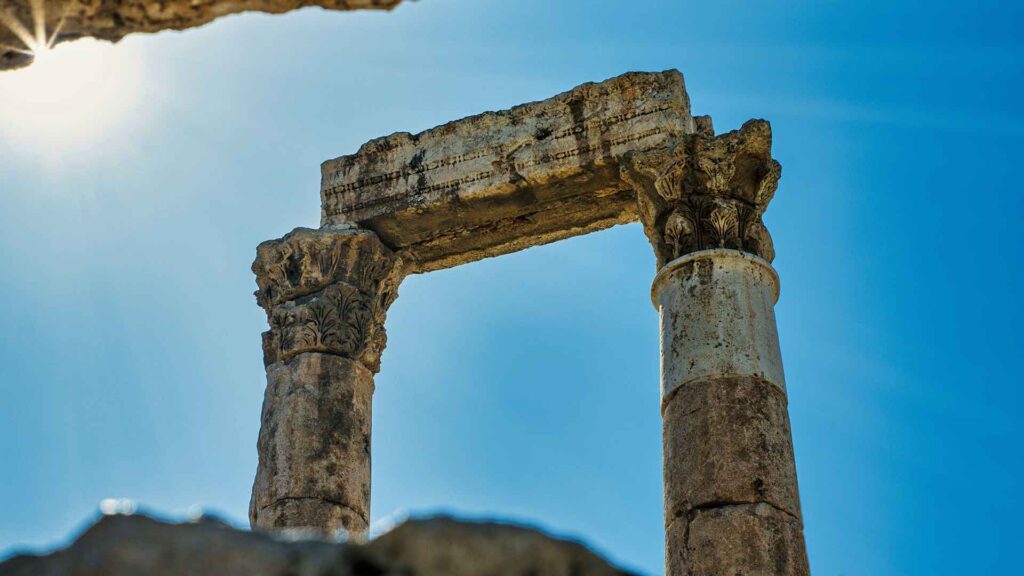

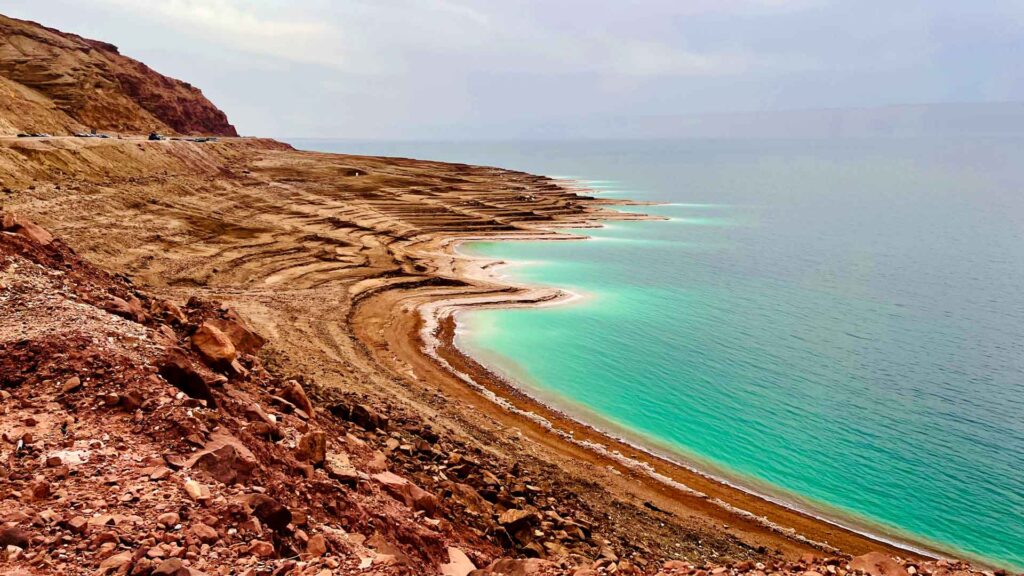
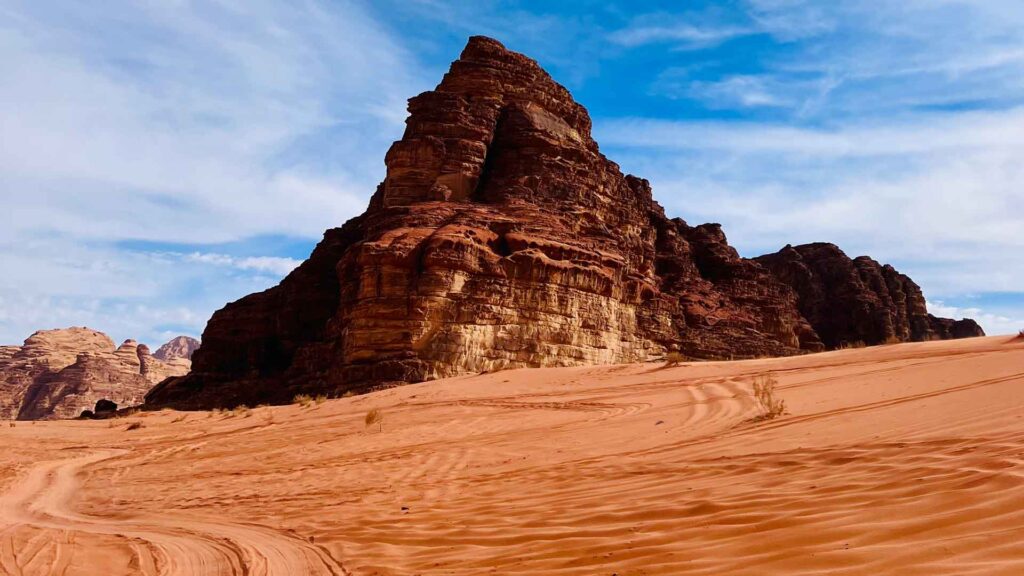
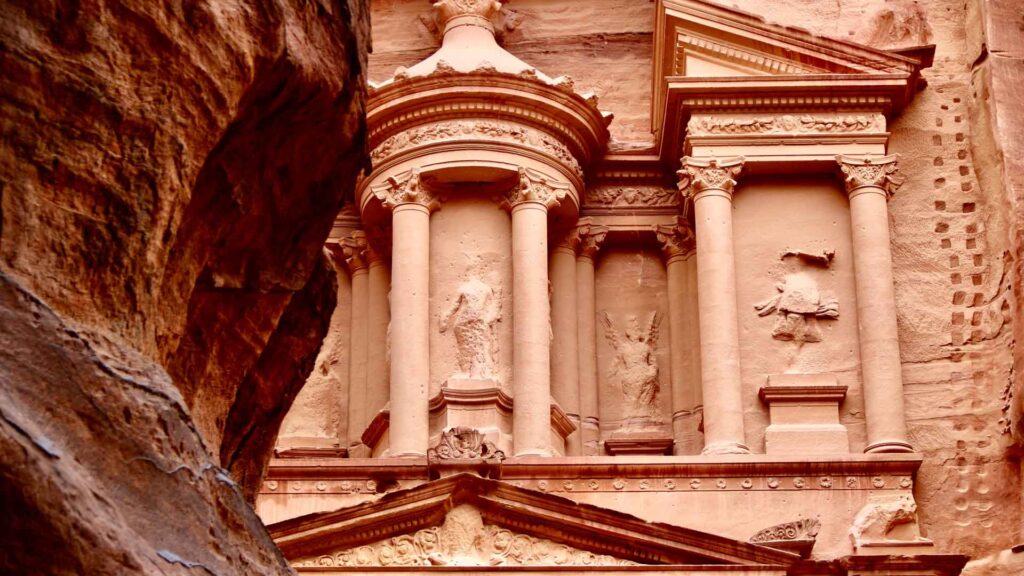
2 Responses
I don’t even know how I stopped up here, however I assumed this submit was greatI don’t understand who you might be however certainly you’re going to a famous blogger when youaren’t already Cheers!
Thank you so much, your words mean a lot 🙂 I’m still a dreamer who traveled and travels a lot and want to share what I learn along the way and hopefully I can reach as many people as possible!